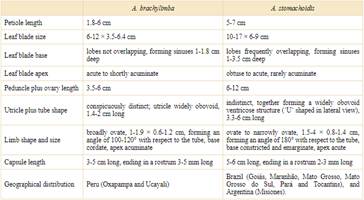INTRODUCTION
Aristolochia L., the largest genus of the family Aristolochiaceae, comprises nearly 560 species mostly diversified in the tropics and subtropics of the Americas (González & Pabón-Mora, 2017; Freitas et al., 2020a). All members of the genus possess alternate, distichous leaves, a perianth formed by the early fusion of three sepals, and an inferior ovary forming capsular fruits. The highly elaborate petaloid perianth is often differentiated into a proximal, inflated portion called the utricle, a narrow middle portion called the tube, and an expanded, laminar portion called the limb (Pfeifer, 1966; González, 1994). In most species of Aristolochia the utricle is considerably shorter than the limb, and the tube is funnel-shaped as it gradually widens towards its distal end. The perianth morphology, epidermal elaboration, and vascular patterning provide key traits to reconstruct the phylogenetic relationships within the genus (González & Stevenson, 2000a), as well as to discover new species (e.g. Freitas et al., 2020b).
All South American species of Aristolochia belong to the subgenus Aristolochia section Gymnolobus Duch. subseries Hexandrae, as the gynostemium is formed by six stamens fused to six stigmatic lobes that lack a transverse roof-like process above the stamens (Duchartre, 1854a, 1864; González, 1991a; González & Stevenson, 2000b). With nearly 140 species, Aristolochia subseries Hexandrae is one of the the most species-rich infrageneric groups worldwide. The series has been divided in two informal groups, namely ´Exstipulosae´ and ´Pseudostipulosae´, with ca. 70 species each (Hoehne, 1942), based on the presence or absence of pseudostipules, respectively. The Aristolochia pseudostipules correspond to reduced prophylls of axillary branches that resemble stipules (for details see Duchartre, 1854b; Hoehne, 1942; González, 1990). While working on the monograph of Aristolochia for Flora Neotropica, three specimens collected in Pasco and Ucayali (Peru) called our attention as it does not match any of the previously described species of the genus in Peru or neighboring countries (cf. Masters, 1875; Malme, 1904; Ule, 1905; Moore, 1915; Hoehne, 1927, 1942; Schmidt, 1927; Macbride, 1937; Ahumada, 1977, 2010; González, 1990, 1991b, 1994, 1998, 2000; Brako & Zarucchi, 1993; León & La Torre, 2006; González et al., 2015; Freitas et al., 2020b). Notably, the utricle in this specimen is considerably longer than the extremely short limb, the tube diameter gradually narrows down towards its distal portion resulting in a conical contour of the tube, and the seeds are winged and flattened. The relative size of the utricle versus the limb and the atypical tube contour were consistently found at various stages from early preanthesis to anthesis (Fig. 1A). The presence of all these uncommon traits simultaneously strongly indicates that it corresponds to an undescribed taxon. In addition to the description of the new species, remarks on the conservation status and the geographical distribution are provided, along with a key to identify all the Exstipulosae species of Aristolochia subser. Hexandrae.
MATERIALS AND METHODS
The type specimens of the new species are deposited at HOXA (Herbario Selva Central Oxapampa, Pasco, Peru), MO (Missouri Botanical Garden herbarium, USA), and USM (Herbario Universidad Nacional Mayor de San Marcos, Lima, Peru). Comparison with similar species was based on extensive herbarium search at B, BM, COL, CONN, CTES, F, GH, K, MO, NY, and US (acronyms follow Thiers, 2023). Additionally, the Jstor Global Plants database (JSTOR, 2021) was consulted, and the available barcode for original material was included. Measurements of leaves, flowers, fruits and seeds were taken from fully formed organs. Terminology used to describe Aristolochia flowers follows Pfeifer (1966), and González (1990, 1994).
The traits of Aristolochia stomachoidis Hoehne, the most similar species to the taxon here described (Table 1), were taken from the descriptions provided by Hoehne (1910, 1927, 1942), Keller (2010) and González et al. (2015), and from direct examination of the following specimens: ARGENTINA. Misiones. Depto. San Ignacio, Club del Río, 27-VII-2008, H. A. Keller 5675 (CTES). BRAZIL. Goiás: Queixada, Yatai, 11-XI-1948 (fl), A. Macedo 1470 (BM, MO); Aragarças, 15°51´S, 52°15´W, km 51 of Aragarças, 14-I-1968 (fl), D. Philcox & E. Fereira 4050 (K). Maranhão: Barra do Corda, Cocal Grande, 34 km NE of Barra do Corda along the río Mearim, 5°24´S, 45°06´W, 7-III-1983 (fl), G. E. Schatz et al. 889 (COL, NY). Mato Grosso: Corrego do Porco, río Suiazinho, c. 24 km along the Suiá-miçu road, 24-X-1968 (fl), R. M. Harley et al. 10834 (K); ao longo dos rios Taruman e Sepotuba, perto de Tapirapoan, Mar 1909 (fl), F. C. Hoehne 1443 (lectotype SP[000413]!); vicinity of Barra do Garças, roadside thicket ca. 50 km N of Barra do Garças on road to Xavantina, 15°53´S, 52°15´W, 300-400 m, 14-X-1964 (fl), H. S. Irwin & T. R. Soderstrom 6830 (MO, NY); Barra do Garças-Xavantina, (fl), E. Onishi & S. G. Fonseca 332/1101 (K); Serra do Roncador, road Chavantina to Barra do Garças, 55 km N of Barra do Garças, 15-X-1964 (fl), G. T. Prance & N. T. Silva 59413 (COL, CONN, NY); ½ km N of the río Suiá-miçu Ferry, appr. 290 km N of Xavantina, 11-V-1968 (fl, fr), J. A. Ratter et al. 1393 (K); río Suaizinha, appr. 280 km N of Xavantina, 11-V-1968 (fl), J. A. Ratter et al. 1395 (K). Mato Grosso do Sul: Bataguassu, Porto XV, 14-II-1970 (fl), G. Hatschbach 23524 (CTES). Pará: Conceição do Araguaia, Alacilândia, 42 km W of Conceição do Araguaia along highway PA-287 at río Arraias do Araguaia, ca. 8º13´S, 49º36´W, 300 m, 23-II-1980 (fl), T. Plowman et al. 9029 (COL); Sete Varas airstrip on Rio Curuá, 54°92´W, 0°95´S, 5-VIII-1981 (fl), J. J. Strudwick & G. L. Sobel 4194 (COL, NY). Tocantins: Rod. Transamazonica, Araguatins, 27-III-1976 (fl), G. Hatschbach 38421 (B, MO, NY).
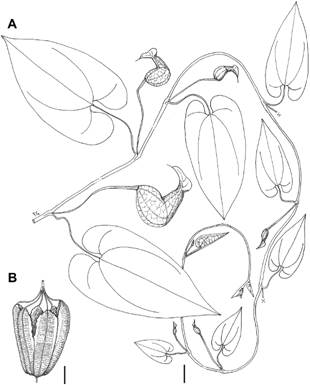
Fig. 1 Aristolochia brachylimba F. González, Pabón-Mora & L. Valenz., sp. nov. (from Valenzuela et al. 12765, HOXA, holotype). A, habit, leaves and flowers. B, capsule at dehiscence. Scale bars: 1 cm.
RESULTS
Aristolochia brachylimba F. González, Pabón-Mora & L. Valenz., sp. nov. TYPE: Perú, Pasco, Oxapampa, Palcazú, Ataz, Yanesha Reserva Camunal, 10°10´12´´S, 75°18´08´´W, 340 m, 21-V-2009 (fl, fr), L. Valenzuela, A. Peña & J. L. Mateo 12765 (holotype HOXA!; isotypes, MO!). Figs. 1-3.
Diagnosis
Aristolochia brachylimba resembles A. stomachoidis, from which it differs mainly by the petiole 1.8-6 cm long, the leaf blade 6-12 × 3.5-6.4 cm, the peduncle plus ovary 3.5-6 cm long, the utricle 1.4-2 cm long, distinct from the tube, and the limb broadly ovate, 1-1.9 × 0.6-1.2 cm, forming an angle of 100-120° with respect to the tube, with cordate base and acuminate apex (versus the petiole 5-7 cm long, the leaf blade 10-17 × 6-9 cm, the peduncle plus ovary 6-12 cm, the utricle indistinct from the tube forming an obovoid ventricose structure (´U´ shaped in lateral view), 3.3-6 cm long, and the limb ovate to narrowly ovate, 1.5-4 × 0.8-1.4 cm, at an angle of 180° with respect to the tube, with constricted and emarginate base and acute apex in A. stomachoidis). The two species have allopatric distribution.
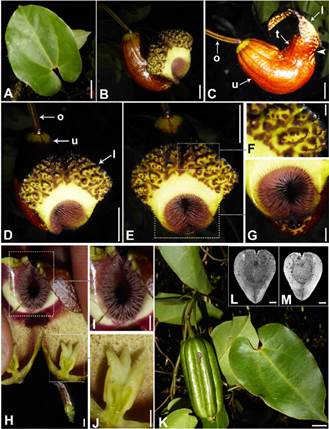
Fig. 2 Aristolochia brachylimba, photographs of type specimens (A-J, L. Valenzuela et al. 39374, paratype; K, L. Valenzuela et al. 39378, paratype; L, M, L. Valenzuela et al. 12765, holotype). A, leaf. B, flower at anthesis. C, perianth, lateral view; note the narrowing of the tube distal portion (arrowhead). D, E, limb, frontal view. F, detail of inner limb surface. G, detail of perianth throat. H, dissected utricle and gynostemium. I, detail of syrinx. J, gynostemium, sagittal section. K, twig with capsule prior dehiscence. L, M, deeds, adaxial (L) and abaxial (M) view. Abbreviations: l, limb; o, ovary; t, tube; u, utricle. Scale bars: 2 cm in A; 5 mm in B-E; 1 mm in F-J, L, M; 1 cm in K. Color version at https://www.ojs.darwin.edu.ar/index.php/darwiniana/article/view/1139/1305
Vines. Stems glabrescent, cylindrical, slender, with internodes 6-11 cm long. Petiole 1.8-6 cm long, glabrescent; blade oblong to narrowly ovate, 6-12 × 3.5-6.4 cm, membranous, adaxial surface glabrous, abaxial surface glabrescent, base cordate, not peltate, lobes parallel to convergent leaving narrow sinuses 1-1.8 cm deep, apex acute to shortly acuminate, basal primary veins 3(5). Pseudostipules absent. Flowers axillary, solitary, ebracteolate. Peduncle plus ovary 3.5-6 cm long, glabrous, with a short (to 0.5 mm) rostrum at the dorsal portion of the ovary tip. Perianth glabrous on its outer surface, reflexed, vinaceous to purple; utricle widely obovoid, 1.4-2 × 0.4-1 cm, syrinx present, aequilateral, ca. 1 mm broad; tube reflexed forming an angle of 80-90° with respect to the utricle, 0.8-1.4 cm long, 5.5-6.5 mm proximal diameter, 3.5-4.5 mm distal diameter, gradually narrowed down towards its distal portion resulting in a conical contour; limb broadly ovate, 1-1.9 cm long (including an acumen 1.5-3 mm), 0.6-1.2 cm wide, forming an angle of 100-120° with respect to the tube, warty to shortly fimbriate on its inner surface, base cordate, apex acuminate; gynostemium 6-lobed, sessile, 4-5 mm long; anthers six, equidistant, oblong, 2.5-3 mm long. Capsule broadly cylindrical, 3-5 cm long including an apical rostrum 3-5 mm long, 1.5-1.8 cm in diameter at its mid-level, basipetally dehiscent, glabrous and smooth externally, midvein of each carpel prominent, ca. 1 mm, septae entire. Seeds broadly ovoid, 8-9 × 6.5-7.5 mm including a membranous, peripheral wing, flattened, warty on both surfaces, seed proper cordiform, 4.0-4.3 × 3.9-4.1, brown, darker than the wing, raphe prominulous.
Distribution, phenology and habitat
Aristolochia brachylimba has been collected in two disjunct localities in Ataz (Oxapampa, Pasco region), and the Cordillera Azul National Park (Ucayali province, Loreto region)(Fig. 3), at elevations between 340 and 479 m a.s.l. The new species sets flowers and fruits in May.
This new species belongs to the Exstipulosae group (sensu Hoehne, 1942), and possesses all diagnostic traits of Aristolochia subser. Hexandrae (sensu González, 1990, 1991a), including the lack of an abscission zone at the base of the petiole, and the solitary, axillary, ebracteolate flowers.
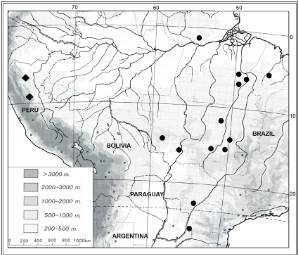
Fig. 3 Map of distribution of Aristolochia brachylimba (diamonds) and its closely related species A. stomachoidis (circles).
Five additional Exstipulosae species of Aristolochia subser. Hexandrae occur in Peru, namely, A. barbouri Barringer (Fig. 4A), endemic to the Department of Madre de Dios; A. chachapoyensis Ahumada (Fig. 4B), from the departments of Amazonas, Cajamarca and San Martín; A. pilosa Kunth (Fig. 4C), widespread from Central America to Bolivia; A. trilabiata Glaziou (Fig. 4D, formerly A. didyma S. Moore; see González & Pabón-Mora, 2018), widely distributed in Panama, Colombia, Ecuador, Venezuela, Peru, Guyanas, Brazil and Bolivia; and A. xerophytica R.E. Schult. (Fig. 4E), from the departments of Cajamarca, La Libertad and Piura. All these species possess a perianth with the tube funnel-shaped, and the utricle shorter than the limb, sharply contrasting to the perianth with the obconic tube and the utricle longer than the limb in the new species. A key to identify these species is provided below.
Etymology
The epithet refers to the unusually short perianth limb that characterizes the new species.
Provisional conservation status
According to the IUCN Red List criteria (IUCN, 2014, 2022), Aristolochia brachylimba should be provisionally considered as Endangered (EN B1ab(iii) + 2ab(iii), D), due to population reduction based on the number of mature individuals known (<1000), small extent of occurrence, small area of occupancy with just one station of occurrence, and habitat reduction in the area.
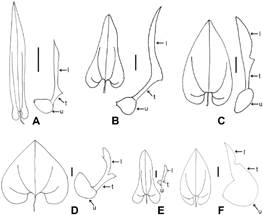
Fig. 4 Outline drawings of leaf and perianth (side view) of the species of Aristolochia subser. Hexandrae from Peru (A-E), and its close relative A. stomachoidis (F), from Brazil. A, A. barbouri (from Barbour 5405, holotype F[F0042307F!]). B, A. chachapoyensis (from Hutchison & Wright 5447, holotype UC[UC1335070!]). C, A. pilosa (from Humboldt & Bonpland s.n., holotype P [P00669996!]). D, A. trilabiata (from Glaziou 10033, lectotype P [P01657954!]). E, A. xerophytica (from Evinger 540, holotype US[US00610968!]). F, A. stomachoidis (from Hoehne 1443, lectotype SP [SP000413!]). Note in A-E the funnel-shaped tube and the shorter utricle with respect to the limb. Abbreviations: l, limb; t, tube; u, utricle. Scale bars: 1 cm.
Notes
The narrowly ovate to oblong leaves, the perianth utricle larger than the limb, the tube gradually narrowing down towards its distal portion, and the capsules and seeds of Aristolochia brachylimba resemble those of A. stomachoidis (Figs. 3, 4F), from northern, central and southeastern Brazil (Goiás, Maranhão, Mato Grosso, Mato Grosso do Sul, Pará and Tocantins), and northeastern Argentina (Misiones). Apart from the allopatric distribution of these two species, the new species differs in the petiole 1.8-6 cm long; the leaf blade 6-12 × 3.5-6.4 cm, with two non-overlapping lobes forming sinuses 1-1.8 cm deep at its base, and an acute to shortly acuminate apex; the peduncle plus ovary 3.5-6 cm long; the utricle widely obovoid, 1.4-2 cm long, distinct from the tube; the limb broadly ovate, 1-1.9 × 0.6-1.2 cm, forming an angle of 100-120° with the tube, cordate at its base and acuminate at its apex; and the capsule 3-5 cm long, ending in a rostrum 3-5 mm long in A. brachylimba (Figs. 1, 2). Rather, A. stomachoidis has longer (5-7 cm) petioles, larger leaf blades (10-17 × 6-9 cm) with two lobes overlapping forming sinuses 1-3.5 cm deep at its base, and an obtuse to acute (rarely shortly acuminate) apex; peduncle plus ovary 6-12 cm; utricle indistinct from the tube, together forming a widely obovoid ventricose structure (´U´ shaped in lateral view), 3.3-6 cm long; limb ovate to narrowly ovate, 1.5-4 × 0.8-1.4 cm, forming an angle of 180° with respect to the tube, basally constricted and emarginate and apically acute; and capsules 5-6 cm long, ending in a rostrum 2-3 mm long (Fig. 4F, Table 1).
Additional specimens studied (Paratypes)
PERU. Loreto Region. Ucayali Province, Pampa Hermosa District, Cordillera Azul National Park, Shanshuico Surveillance Post, Amazon forest, silt-clay soil, 07°21´22.2´´S, 076°00´27.6´´W, 479 m, 11-V-11, 2021 (fl), L. Valenzuela A. García, R. García & J. Salazar 39374 (HOXA, MO, USM); Ucayali Province, Pampa Hermosa District, Cordillera Azul National Park, Shanshuico Surveillance Post, primary Amazon Forest, silt-clay soil, 07°21´22.2´´S, 076°00´27.6´´W, 479 m, 11-V-2021 (fr), L. Valenzuela, A. García, R. García & J. Salazar 39378 (HOXA, MO, USM).
Key to the Exstipulosae species of Aristolochia subser. Hexandrae from Peru
1. Perianth tube conical (i.e. gradually narrowing down towards its distal end), and limb shorter than the utricle. Seeds flattened, winged ....................................................................................................................................... A. brachylimba
1. Perianth tube funnel-shaped, and limb 2 to 5 times longer than the utricle (if shorter, then the limb trilobed in A. trilabiata). Seeds concave-convex, not winged ...................................................................................................... 2
2(1). Stems, leaves, flowers and fruits denselly hirsute-pilose, trichomes septate .................................. A. pilosa Kunth
2. Stems, leaves, flowers and fruits glabrous to puberulous but never hirsute-pilose nor with septate trichomes .......... 3
3(2). Petiole 5-30 cm long, glabrous; leaf blade ovate to broadly ovate, 9-29 × 10-28 cm, almost as long as wide. Floral peduncle and ovary 11-21 cm long, glabrous. Perianth strongly reflexed between the utricle and the tube, these forming an angle of ca. 30°; utricle 46-75 × 22-40 mm; tube 2.5-8 cm long; limb trilobed, the upper two lips formed at the flanks of the dorsal midvein, each 3.5-6.8 × 2-3.5 cm, separated by a sinus 1-3.5 cm depth, with marginal fimbriae to 6 mm long, the lower lip median, widely ovate, 1-2 × 1.4-2.5 cm; gynostemium 10-15 × 6-10 mm. Capsule very narrowly cylindric,10-25 × 1.5-2.5 cm; seeds with a sticky aril around the raphe. Widespread in rainforests of Panamá, Colombia, Ecuador, Venezuela, Perú, Guyanas, Brazil, and Bolivia ................................................................. A. trilabiata Glaziou
3. Petiole 0.8-3.5 cm long; leaf blade narrowly to very narrowly ovate (rarely ovate), 3-16 × 1.4-7 cm, 2 to 7 times longer than wide. Floral peduncle and ovary 1.8-5 cm long, puberulous. Perianth very slightly arched between the utricle and the tube, these forming angles ≥ 110°; utricle 5-14 × 4-8 mm; tube 8-26 mm long; limb unilobed, narrowly ovate, ovate or spathulate, 2-6.5 × 0.4-1.6 cm, efimbriate or, in A. xerophytica, with fimbriae less than 3 mm long; gynostemium 2.5-5 × 3.5-4.5 mm. Capsule cylindric, 1.5-4 × 1-1.8 cm; seeds concave-convex, exarillate. Endemic to Peru ............................ 4
4(3). Leaf blade very narrowly ovate, 10-16 × 1.4-2 cm, 5 to 7 times longer than wide, not constricted at its midportion, with basal lobes parallel to convergent; primary basal veins three. Gynostemium 4-5 mm long. Capsule 3.5-4 cm long, including a rostrum 6-8 mm long. Endemic to Madre de Dios (Peru), in Amazonian rainforests at elevations below 300 m a.s.l. ........................................................................................................ A. barbouri Barringer
4. Leaf blade narrowly ovate, 3.5-11.4 × 2-7 cm, 2 to 4 times longer than wide, often constricted at its mid-portion, with basal lobes divergent, rarely parallel; primary basal veins five. Gynostemium 2.5-4 mm long. Capsule 2.5-3.2 cm long, including a rostrum 1-5 mm long. Dry thickets of Amazonas, Cajamarca, La Libertad, Piura and San Martín (Peru), at elevations between 700 and 1500 m a.s.l. .................................................................................................................. 5
5(4). Stems, petiole, and floral peduncle glabrescent. Limb of the perianth narrowly to very narrowly ovate, not spathulate, 4-6.5 cm long, slightly cuculate, forming a wide angle of 110-120° with respect to the tube, efimbriate, apex acuminate .................................................................................................................... A. chachapoyensis Ahumada
5. Stems, petiole, and floral peduncle puberulous. Limb of the perianth ovate to slightly spathulate, 2-4 cm long, not cuculate, forming a sharp angle of 90-120o with respect to the tube, fimbriate on its margins and its inner surface, apex acute to obtuse, sometimes mucronulate ................................................................................ A. xerophytica R.E. Schult.












 uBio
uBio 
